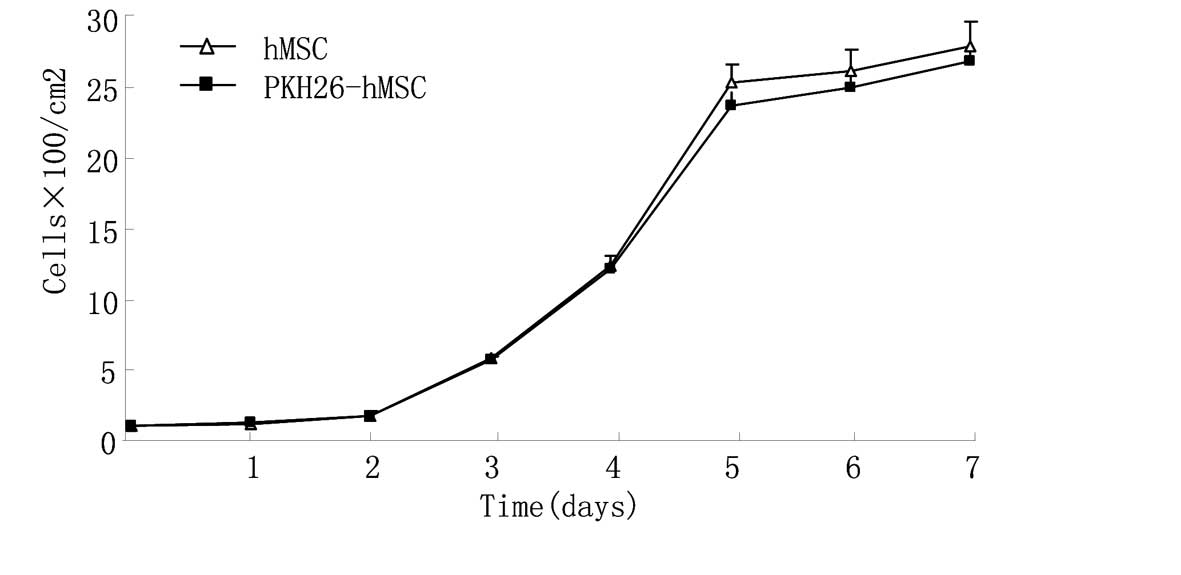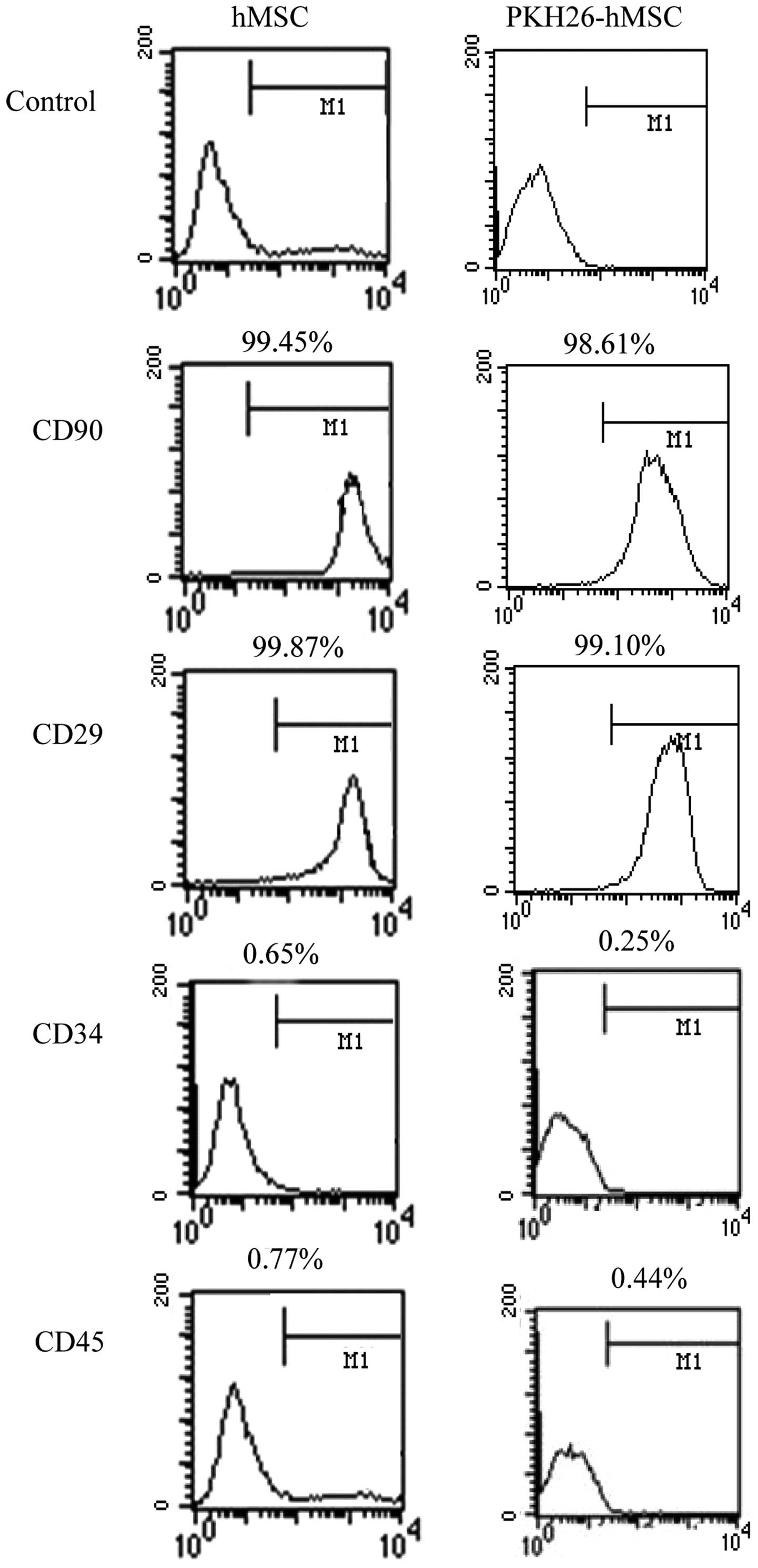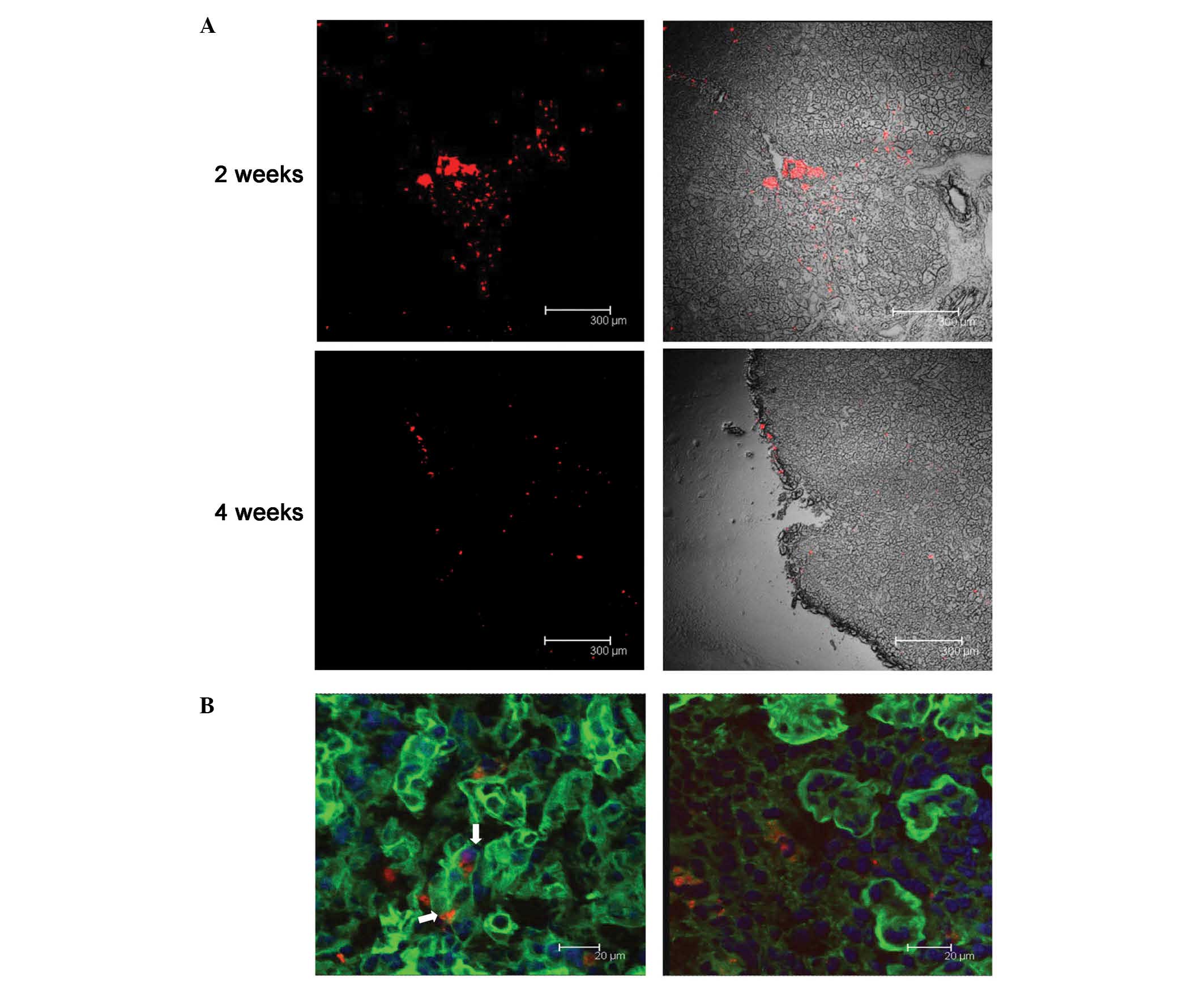|
1
|
Morigi M and Benigni A: Mesenchymal stem
cells and kidney repair. Nephrol Dial Transplant. 28:788–793.
View Article : Google Scholar : PubMed/NCBI
|
|
2
|
Imai E and Iwatani H: The continuing story
of renal repair with stem cells. J Am Soc Nephrol. 18:2423–2424.
2007. View Article : Google Scholar : PubMed/NCBI
|
|
3
|
Yuan L, Wu MJ, Sun HY, Xiong J, Zhang Y,
Liu CY, Fu LL, Liu DM, Liu HQ and Mei CL: VEGF-modified human
embryonic mesenchymal stem cell implantation enhances protection
against cisplatin-induced acute kidney injury. Am J Physiol Renal
Physiol. 300:F207–F218. 2011. View Article : Google Scholar : PubMed/NCBI
|
|
4
|
Selby NM, Crowley L, Fluck RJ, Mcintyre
CW, Monaghan J, Lawson N and Kolhe NV: Use of electronic results
reporting to diagnose and monitor AKI in hospitalized patients.
Clin J Am Soc Nephrol. 7:533–540. 2012. View Article : Google Scholar : PubMed/NCBI
|
|
5
|
Morigi M, Imberti B, Zoja C, Corna D,
Tomasoni S, Abbate M, Rottoli D, Angioletti S, Benigni A, Perico N,
et al: Mesenchymal stem cells are renotropic, helping to repair the
kidney and improve function in acute renal failure. J Am Soc
Nephrol. 15:1794–1804. 2004. View Article : Google Scholar : PubMed/NCBI
|
|
6
|
Bussolati B, Hauser PV, Carvalhosa R and
Camussi G: Contribution of stem cells to kidney repair. Curr Stem
Cell Res Ther. 4:2–8. 2009. View Article : Google Scholar : PubMed/NCBI
|
|
7
|
Chhabra P and Brayman KL: The use of stem
cells in kidney disease. Curr Opin Organ Transplant. 14:72–78.
2009. View Article : Google Scholar : PubMed/NCBI
|
|
8
|
Yokote S, Yamanaka S and Yokoo T: De novo
kidney regeneration with stem cells. J Biomed Biotechnol.
2012:4535192012. View Article : Google Scholar : PubMed/NCBI
|
|
9
|
Hwang JH, Shim SS, Seok OS, Lee HY, Woo
SK, Kim BH, Song HR, Lee JK and Park YK: Comparison of cytokine
expression in mesenchymal stem cells from human placenta, cord
blood, and bone marrow. J Korean Med Sci. 24:547–554. 2009.
View Article : Google Scholar : PubMed/NCBI
|
|
10
|
Cao H, Heazlewood SY, Williams B, Cardozo
D, Nigro J, Oteiza A and Nilsson SK: The role of CD44 in fetal and
adult hematopoietic stem cell regulation. Haematologica. 101:26–37.
2016. View Article : Google Scholar : PubMed/NCBI
|
|
11
|
Gotherstrom C, Ringden O, Westgren M,
Tammik C and Le Blanc K: Immunomodulatory effects of human foetal
liver-derived mesenchymal stem cells. Bone Marrow Transplant.
32:265–272. 2003. View Article : Google Scholar : PubMed/NCBI
|
|
12
|
Li O, Tormin A, Sundberg B, Hyllner J, Le
Blanc K and Scheding S: Human embryonic stem cell-derived
mesenchymal stroma cells (hES-MSCs) engraft in vivo and support
hematopoiesis without suppressing immune function: Implications for
off-the shelf ES-MSC therapies. PLoS One. 8:e553192013. View Article : Google Scholar : PubMed/NCBI
|
|
13
|
O'Donoghue K and Fisk NM: Fetal stem
cells. Best Pract Res Clin Obstet Gynaecol. 18:853–875. 2004.
View Article : Google Scholar : PubMed/NCBI
|
|
14
|
Le Blanc K: Immunomodulatory effects of
fetal and adult mesenchymal stem cells. Cytotherapy. 5:485–489.
2003. View Article : Google Scholar : PubMed/NCBI
|
|
15
|
Le Blanc K, Tammik L, Sundberg B,
Haynesworth SE and Ringden O: Mesenchymal stem cells inhibit and
stimulate mixed lymphocyte cultures and mitogenic responses
independently of the major histocompatibility complex. Scand J
Immunol. 57:11–20. 2003. View Article : Google Scholar : PubMed/NCBI
|
|
16
|
Emanueli C, Lako M, Stojkovic M and
Madeddu P: In search of the best candidate for regeneration of
ischemic tissues: Are embryonic/fetal stem cells more advantageous
than adult counterparts? Thromb Haemost. 94:738–749.
2005.PubMed/NCBI
|
|
17
|
Wu M, Yang L, Liu S, Li H, Hui N, Wang F
and Liu H: Differentiation potential of human embryonic mesenchymal
stem cells for skin-related tissue. Br J Dermatol. 155:282–291.
2006. View Article : Google Scholar : PubMed/NCBI
|
|
18
|
Institute of Laboratory Animal Resources
(US). Committee on Care, Use of Laboratory Animals, and National
Institutes of Health (US). Division of Research Resources: Guide
for the care and use of laboratory animals (8th). National
Academies Press. (Washington, DC). 2011.
|
|
19
|
Schimke MM, Marozin S and Lepperdinger G:
Patient-specific age: The other side of the coin in advanced
mesenchymal stem cell therapy. Front Physiol. 6:3622005.
|
|
20
|
Sterneckert JL, Reinhardt P and Scholer
HR: Investigating human disease using stem cell models. Nat Rev
Genet. 15:625–639. 2014. View
Article : Google Scholar : PubMed/NCBI
|
|
21
|
Allers C, Lasala GP and Minguell JJ:
Presence of osteoclast precursor cells during ex vivo expansion of
bone marrow-derived mesenchymal stem cells for autologous use in
cell therapy. Cytotherapy. 16:454–459. 2013. View Article : Google Scholar : PubMed/NCBI
|
|
22
|
Semon JA, Maness C, Zhang X, Sharkey SA,
Beuttler MM, Shah FS, Pandey AC, Gimble JM, Zhang S, Scruggs BA, et
al: Comparison of human adult stem cells from adipose tissue and
bone marrow in the treatment of experimental autoimmune
encephalomyelitis. Stem Cell Res Ther. 5:22014. View Article : Google Scholar : PubMed/NCBI
|
|
23
|
Barry FP and Murphy JM: Mesenchymal stem
cells: Clinical applications and biological characterization. Int J
Biochem Cell Biol. 36:568–584. 2004. View Article : Google Scholar : PubMed/NCBI
|
|
24
|
Zhang ZY, Teoh SH, Chong MS, Schantz JT,
Fisk NM, Choolani MA and Chan J: Superior osteogenic capacity for
bone tissue engineering of fetal compared with perinatal and adult
mesenchymal stem cells. Stem Cells. 27:126–137. 2009. View Article : Google Scholar : PubMed/NCBI
|
|
25
|
Kawaguchi K, Katsuyama Y, Kikkawa S, Setsu
T and Terashima T: PKH26 is an excellent retrograde and anterograde
fluorescent tracer characterized by a small injection site and
strong fluorescence emission. Arch Histol Cytol. 73:65–72. 2010.
View Article : Google Scholar : PubMed/NCBI
|
|
26
|
Gallagher SJ, Shank JA, Bochner BS and
Wagner EM: Methods to track leukocyte and erythrocyte transit
through the bronchial vasculature in sheep. J Immunol Methods.
271:89–97. 2002. View Article : Google Scholar : PubMed/NCBI
|
|
27
|
Ude CC, Shamsul BS, Ng MH, Chen HC,
Norhamdan MY, Aminuddin BS and Ruszymah BH: Bone marrow and adipose
stem cells can be tracked with PKH26 until post staining passage 6
in in vitro and in vivo. Tissue Cell. 44:156–163. 2012. View Article : Google Scholar : PubMed/NCBI
|
|
28
|
Shao-Fang Z, Hong-Tian Z, Zhi-Nian Z and
Yuan-Li H: PKH26 as a fluorescent label for live human umbilical
mesenchymal stem cells. In Vitro Cell Dev Biol Anim. 47:516–520.
2011. View Article : Google Scholar : PubMed/NCBI
|
|
29
|
Haas SJ, Bauer P, Rolfs A and Wree A:
Immunocytochemical characterization of in vitro PKH26-labelled and
intracerebrally transplanted neonatal cells. Acta Histochem.
102:273–280. 2000. View Article : Google Scholar : PubMed/NCBI
|
|
30
|
Fox IJ, Daley GQ, Goldman SA, Huard J,
Kamp TJ and Trucco M: Stem cell therapy. Use of differentiated
pluripotent stem cells as replacement therapy for treating disease.
Science. 345:12473912014. View Article : Google Scholar : PubMed/NCBI
|
|
31
|
Pan Q, Qin X, Ma S, Wang H, Cheng K, Song
X, Gao H, Wang Q, Tao R, Wang Y, et al: Myocardial protective
effect of extracellular superoxide dismutase gene modified bone
marrow mesenchymal stromal cells on infarcted mice hearts.
Theranostics. 4:475–486. 2014. View Article : Google Scholar : PubMed/NCBI
|
|
32
|
Rashid ST and Vallier L: Induced
pluripotent stem cells-alchemist's tale or clinical reality? Expert
Rev Mol Med. 12:252010. View Article : Google Scholar : PubMed/NCBI
|
|
33
|
Togel F, Hu Z, Weiss K, Isaac J, Lange C
and Westenfelder C: Administered mesenchymal stem cells protect
against ischemic acute renal failure through
differentiation-independent mechanisms. Am J Physiol Renal Physiol.
289:F31–F42. 2005. View Article : Google Scholar : PubMed/NCBI
|
|
34
|
Semedo P, Palasio CG, Oliveira CD, Feitoza
CQ, Gonçalves GM, Cenedeze MA, Wang PM, Teixeira VP, Reis MA,
Pacheco-Silva A and Câmara NO: Early modulation of inflammation by
mesenchymal stem cell after acute kidney injury. Int
Immunopharmacol. 9:677–682. 2009. View Article : Google Scholar : PubMed/NCBI
|
|
35
|
Gatti S, Bruno S, Deregibus MC, Sordi A,
Cantaluppi V, Tetta C and Camussi G: Microvesicles derived from
human adult mesenchymal stem cells protect against
ischaemia-reperfusion-induced acute and chronic kidney injury.
Nephrol Dial Transplant. 26:1474–1483. 2011. View Article : Google Scholar : PubMed/NCBI
|
|
36
|
Bruno S, Grange C, Deregibus MC, Calogero
RA, Saviozzi S, Collino F, Morando L, Busca A, Falda M, Bussolati
B, et al: Mesenchymal stem cell-derived microvesicles protect
against acute tubular injury. J Am Soc Nephrol. 20:1053–1067. 2009.
View Article : Google Scholar : PubMed/NCBI
|
|
37
|
Poulsom R, Forbes SJ, Hodivala-Dilke K,
Ryan E, Wyles S, Navaratnarasah S, Jeffery R, Hunt T, Alison M,
Cook T, et al: Bone marrow contributes to renal parenchymal
turnover and regeneration. J Pathol. 195:229–235. 2001. View Article : Google Scholar : PubMed/NCBI
|
|
38
|
Gupta S, Verfaillie C, Chmielewski D, Kim
Y and Rosenberg ME: A role for extrarenal cells in the regeneration
following acute renal failure. Kidney Int. 62:1285–1290. 2002.
View Article : Google Scholar : PubMed/NCBI
|
|
39
|
Broekema M, Harmsen MC, Koerts JA,
Petersen AH, van Luyn MJ, Navis G and Popa ER: Determinants of
tubular bone marrow-derived cell engraftment after renal
ischemia/reperfusion in rats. Kidney Int. 68:2572–2581. 2005.
View Article : Google Scholar : PubMed/NCBI
|
|
40
|
Lin F, Moran A and Igarashi P: Intrarenal
cells, not bone marrow-derived cells, are the major source for
regeneration in postischemic kidney. J Clin Invest. 115:1756–1764.
2005. View Article : Google Scholar : PubMed/NCBI
|
|
41
|
Duffield JS, Park KM, Hsiao LL, Kelley VR,
Scadden DT, Ichimura T and Bonventre JV: Restoration of tubular
epithelial cells during repair of the postischemic kidney occurs
independently of bone marrow-derived stem cells. J Clin Invest.
115:1743–1755. 2005. View Article : Google Scholar : PubMed/NCBI
|
|
42
|
Duffield JS and Bonventre JV: Kidney
tubular epithelium is restored without replacement with bone
marrow-derived cells during repair after ischemic injury. Kidney
Int. 68:1956–1961. 2005. View Article : Google Scholar : PubMed/NCBI
|
|
43
|
Morigi M, Rota C, Montemurro T,
Montelatici E, Lo Cicero V, Imberti B, Abbate M, Zoja C, Cassis P,
Longaretti L, et al: Life-sparing effect of human cord
blood-mesenchymal stem cells in experimental acute kidney injury.
Stem Cells. 28:513–522. 2010.PubMed/NCBI
|
|
44
|
Sorokin L and Ekblom P: Development of
tubular and glomerular cells of the kidney. Kidney Int. 41:657–664.
1992. View Article : Google Scholar : PubMed/NCBI
|
|
45
|
Narbaitz R, Vandorpe D and Levine DZ:
Differentiation of renal intercalated cells in fetal and postnatal
rats. Anat Embryol (Berl). 183:353–361. 1991. View Article : Google Scholar : PubMed/NCBI
|
|
46
|
Yokoo T, Ohashi T, Shen JS, Sakurai K,
Miyazaki Y, Utsunomiya Y, Takahashi M, Terada Y, Eto Y, Kawamura T,
et al: Human mesenchymal stem cells in rodent whole-embryo culture
are reprogrammed to contribute to kidney tissues. Proc Natl Acad
Sci USA. 102:3296–3300. 2005. View Article : Google Scholar : PubMed/NCBI
|
|
47
|
Herzog EL and Krause DS: Engraftment of
marrow-derived epithelial cells: The role of fusion. Proc Am Thorac
Soc. 3:691–695. 2006. View Article : Google Scholar : PubMed/NCBI
|
|
48
|
Fang TC, Alison MR, Cook HT, Jeffery R,
Wright NA and Poulsom R: Proliferation of bone marrow-derived cells
contributes to regeneration after folic acid-induced acute tubular
injury. J Am Soc Nephrol. 16:1723–1732. 2005. View Article : Google Scholar : PubMed/NCBI
|
|
49
|
Yadav N, Rao S, Bhowmik DM and
Mukhopadhyay A: Bone marrow cells contribute to tubular epithelium
regeneration following acute kidney injury induced by mercuric
chloride. Indian J Med Res. 136:211–220. 2012.PubMed/NCBI
|















